Lawrence Cunningham has a soothing historical perspective on the mass of law firm layoffs at Steel, Patience amid Adversity:
In September 2001, after terrorists attacked lower Manhattan, the stock market closed for several days. Corporate finance and deal activity contracted. Law firms lost work. Associates were let go and firms cut back hiring. Eventually, work resumed, with deal flow flourishing.
Then a professor, I went to the library to leaf through the law reviews published in the period just after the bombing of Pearl Harbor that brought the United States into World War II. I also read books about law firms during that period.
Amid World War II, people were terrified, deal flow contracted, associates at large firms were let go and hiring contracted. Scholarship appeared to have been cut back, but in corporate and securities law, did not seem to abate or shift course due to the attacks or resulting war. Eventually, the war ended, markets resumed, expanded, deals flowed, associates were hired, paid, made partner, and prosperity resumed.
Ditto with the episodic booms, busts, scandals and havoc that have ensued—the 1960s electronics boom and bust; the 1970s foreign bribery scandals; the Vietnam conflict and related upheaval; the 1980s savings & laon crisis; the 1980s/90s junk bond boom and bust; the late 1990s / early 2000s telecom boom and bust; and the current crisis, and its coming resolution.
Patience is a virtue for all those affected by adversity, whether economic, military or otherwise.
There's more, but I want to focus the part I quoted. Yes, it's good to learn from history. And indeed, the business cycle tends to repeat. But there are two reasons why I can't quite feel soothed. First, there's the question of which is the right parallel. We're not in 1929 yet, and I still think the smart bet is that we won't get there, but until we see a floor, we can't be sure about that. Especially since just about the entire minority party in Congress, which includes a blocking minority in the Senate, has wedded itself to idiocies such as being for economic stimulus but against spending. Yes, I actually heard a senator say that on the radio last week. And there's lots of it around.
Second, as regards the legal profession we face structural changes not encountered in a while. And I don't mean the likely collapse of the inflated salary structure (and unhealthy billables/month) for the best-compensated associates (and, I'd argue, partners). That's minor compared to the competition from off-shoring legal suppliers in India and elsewhere, not to mention the looming, inevitable, introduction of computer-assisted legal drafting.
Is it time to start writing the contract-generating AI of the future?

